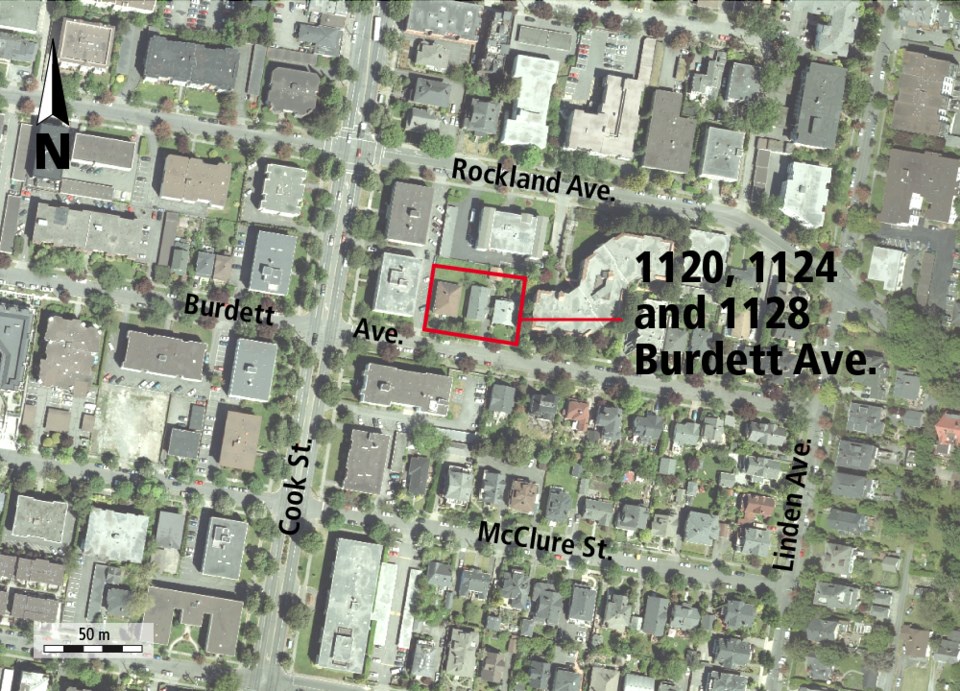Pushback against a proposed rental apartment building in south Fairfield could be a sign of “change fatigue” in a rapidly changing city, Victoria Mayor Lisa Helps says.
“I don’t necessarily think that council or the city or the community has necessarily done the best job of managing and stewarding change in a way that everyone sees the benefits or that’s sustainable,” she said.
Helps noted that Victoria grew almost at the same rate as Langford between 2011 and 2016. “That’s something that I’m grappling with right now as I kind of prepare for the [municipal election] campaign. There’s a lot of change going on. How do we make sure that as change is happening, everyone is heard and everyone benefits?”
The Empresa Properties and Low Hammond Rowe Architects proposal to build a “boutique” 44-unit apartment, at 1120, 1124 and 1128 Burdett Ave., failed on a tie council vote last week after a lengthy and heated public hearing. “I’m really disappointed,” Helps said of the decision.
“I think we went in the wrong direction,” she said, adding that at least two downtown employers told the hearing potential employees can’t find rental housing.
About 40 people spoke, with slightly more than half against the proposal.
The hearing seemed to highlight a divide between younger and older residents, Coun. Chris Coleman said. “It was really obvious there was this divide between an older group who live in the area and are concerned about the redevelopment of the street, and a younger demographic who want to live in the area,” said Coleman, council liaison for the neighbourhood. “It was one of those ones that I was going to feel lousy either way,” said Coleman. “There were good, substantive arguments on both sides. … It was one of those ones where I went: ‘I’m going to vote against some very needed rental stock and it’s tough.’
Coleman was joined by councillors Charlayne Thornton-Joe, Pam Madoff and Geoff Young in voting against the four-storey apartment building with underground parking.
In favour were Helps and councillors Jeremy Loveday, Margaret Lucas and Marianne Alto. Coun. Ben Isitt recused himself to avoid perception of a conflict.
The development originally came before council as 36 condominium units, but was redesigned into a market-rental bid.
It was to be built on lots now occupied by three 1920s-era homes with four- or five-storey apartment buildings on all flanks. Across the street, however, are lower-density, single-family-style homes.
A number of variances were sought, including: an increase in height to 13.53 metres from 12 metres; an increase in the site coverage to 51.42 per cent from 40 per cent; a reduction in the open space to 46.58 per cent from 50 per cent; a reduction in the front yard setback to 5.1 metres from 10.5 metres; reductions in the side setbacks from 6.77 metres to 3.75 metres and 4.22 metres; and a reduction in the number of parking spaces to 36 from 53.
Many in opposition raised concerns about density, shadowing, loss of privacy, and worries about light and parking. They said the plan didn’t fit with the community plan. Gary Kirk circulated a petition that collected 150 signatures of people in opposition.
“The plan presents an unwelcoming densification of a traditional residential street,” Kirk said.
Those in favour included employers and younger employees, who have struggled to find accommodation.
Helps said many of the people who spoke against it are living in buildings that probably needed even more variances when they were permitted by a past council.
“When their homes were built, there were probably people who came and spoke at city council and said: ‘Don’t do this.’ The council of the day made a decision to do it and now they have nice homes in a nice neighbourhood,” Helps said.
Many pointed out that while rental, the units were to be market units rather than affordable units. Traditionally, housing is considered affordable if it doesn’t cost more than 30 per cent of a person’s income.
Helps said some experts say affordability should include transportation costs and that if those costs are 45 per cent or less of a person’s income, that translates into affordability.
“This building, if you work downtown, the transportation costs are zero per cent,” she said. “That makes this place affordable.”



